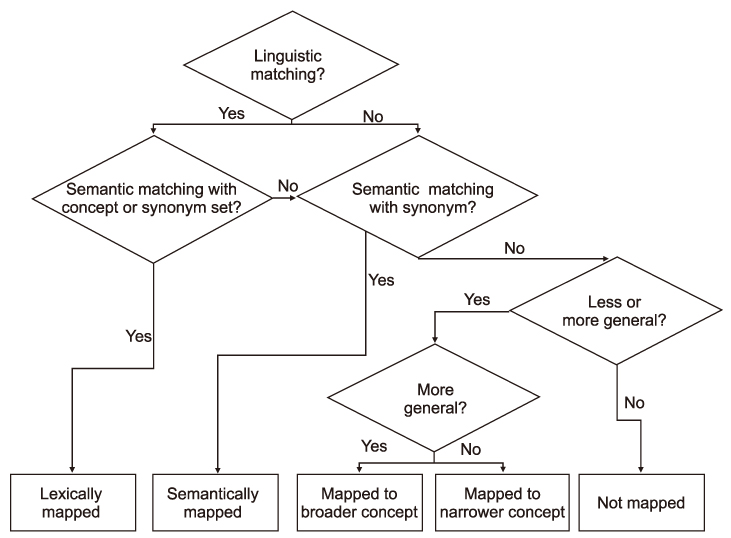Healthc Inform Res.
2010 Jun;16(2):82-88. 10.4258/hir.2010.16.2.82.
Evaluation of the Clinical Data Dictionary (CiDD)
- Affiliations
-
- 1College of Nursing, Seoul National University, Seoul, Korea. hapark@snu.ac.kr
- 2Korea Institute of Radiological & Medical Sciences, Seoul, Korea.
- KMID: 2166571
- DOI: http://doi.org/10.4258/hir.2010.16.2.82
Abstract
OBJECTIVES
The purpose of the study was to evaluate content coverage and data quality of the Clinical Data Dictionary (CiDD) developed by the Center for Interoperable EHR (CiEHR).
METHODS
A total of 12,994 terms were collected from 98 clinical forms of a tertiary cancer center hospital with 500 beds. After data cleaning, 9,418 terms were mapped with the data items of the CiDD by the research team, and validated by 30 doctors and nurses at the research hospital.
RESULTS
Mapping results were classified into five categories: lexically mapped; semantically mapped; mapped to either a broader term or a narrower term; mapped to more than one term and not mapped. In terms of coverage, out of 9,418 terms, 6,750 (71.7%) terms were mapped; 4,319 (45.9%) terms were lexically mapped; 2,431 (25.8%) were semantically mapped; 281 (3.0%) terms were mapped to a broader term; 43 (0.5%) were mapped to a narrower term; and 550 (5.8%) were mapped to more than one term. In terms of data quality, the CiDD has problems such as errors in concept namingand representation, redundancy in synonyms, inadequate synonyms, and ambiguity in meaning.
CONCLUSIONS
Although the CiDD has terms covering 72% of local clinical terms, the CiDD can be improved by cleaning up errors and redundancies, adding textual definitions or use cases of the concept, and arranging the concepts in a hierarchy.
MeSH Terms
Figure
Reference
-
1. AHIMA e-HIM Workgroup on EHR Data Content. Guidelines for developing a data dictionary. J AHIMA. 2006. 77:64A–64D.2. Healthcare terminologies and classifications: an action agenda for the United States. American Medical Informatics Association and American Health Information Management Association Terminology and Classification Policy Task Force. 2006. cited at 2010 June 24. Bethesa (MD): American Medical Informatics Association;Available from: http://library.ahima.org/xpedio/groups/public/documents/ahima/bok1_032395.pdf.3. Yun JH, Kim MJ, Ahn SJ, Kwak MS, Kim Y, Kim HK. The development of clinical terminology dictionary for integration and management of clinical terminologies in EMR Systems. J Korean Soc Med Inform. 2009. 15:411–421.
Article4. Wang Y, Patrick J, Miller G, O'Halloran J, editors. Linguistic mapping of terminologies to SNOMED CT. Proceedings of Semantic Mining Conference on SNOMED-CT. 2006 Oct 13; Copenhagen. Available from: http://jodi.tamu.edu/Articles/v01/i08/Doerr/ [cited at 2010 Mar 3].5. Avesani P, Giunchiglia F, Yatskevich M. A large scale taxonomy mapping evaluation. Lect Notes Comput Sci. 2005. 3729:67–81.
Article6. Doerr M. Semantic problems of thesaurus mapping. J Digit Inf [Internet]. 2001. 1:Available from: http://journals.tdl.org/jodi/article/view/31 [citied at 2010 Mar 3].7. Choe IS. Evaluation and quality control of data in the digital library system. J Korean Soc Libr Inf Sci. 2004. 38:119–139.
Article8. Yeganeh NK, Sadiq S, Deng K, Zhou X. Li Q, Feng L, Pei J, editors. Data quality aware queries in collaborative information systems. Advances in data and web management. 2009. Berlin: Springer;39–50.
Article9. Pipino L, Lee YW, Wang RY. Data quality assessment. Commun ACM. 2002. 45:211–218.
Article
- Full Text Links
- Actions
-
Cited
- CITED
-
- Close
- Share
- Similar articles
-
- The Development of Clinical Terminology Dictionary for Integration and Management of Clinical Terminologies in EMR Systems
- Efforts to prepare inter-Korea medical consolidation: compilation of a medical dictionary for all of Korea
- ANNO: A General Annotation Tool for Bilingual Clinical Note Information Extraction
- ManBIF: a Program for Mining and Managing Biobank Impact Factor Data
- Shame in Korean Language: Factor Analysis of Shame-Related Adjectives



